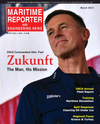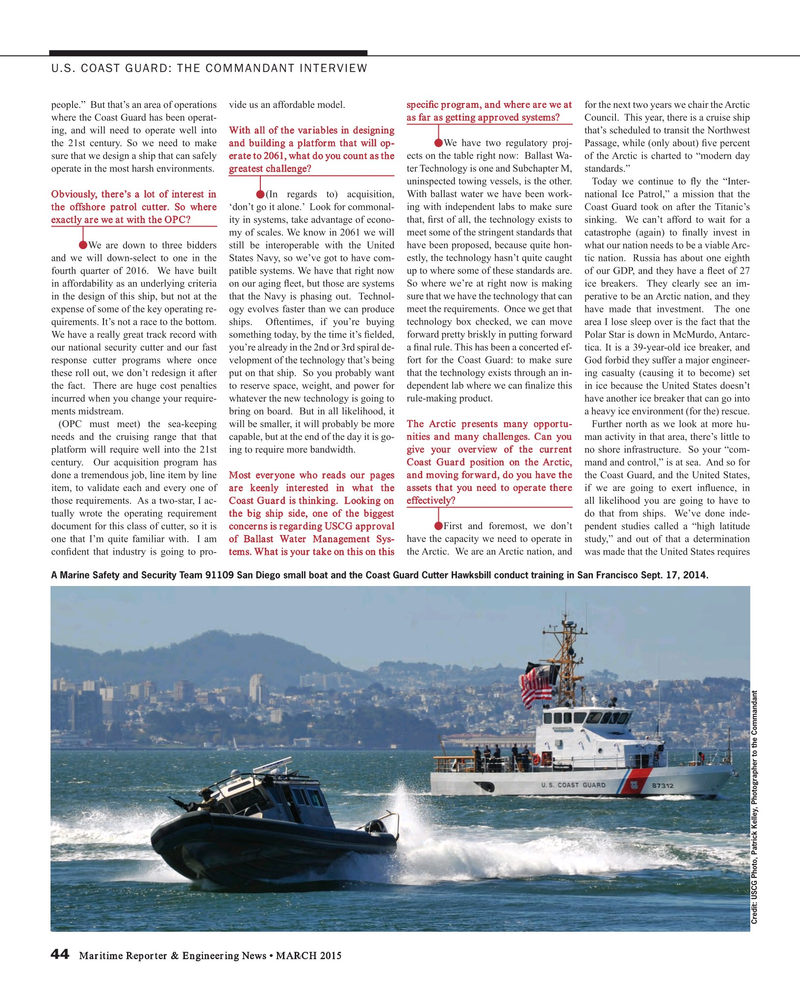
Page 44: of Maritime Reporter Magazine (March 2015)
U.S. Coast Guard Annual
Read this page in Pdf, Flash or Html5 edition of March 2015 Maritime Reporter Magazine
U.S. COAST GUARD: THE COMMANDANT INTERVIEW people.” But that’s an area of operations vide us an affordable model. speci? c program, and where are we at for the next two years we chair the Arctic where the Coast Guard has been operat- as far as getting approved systems? Council. This year, there is a cruise ship ing, and will need to operate well into With all of the variables in designing that’s scheduled to transit the Northwest the 21st century. So we need to make and building a platform that will op- We have two regulatory proj- Passage, while (only about) ? ve percent sure that we design a ship that can safely erate to 2061, what do you count as the ects on the table right now: Ballast Wa- of the Arctic is charted to “modern day operate in the most harsh environments. greatest challenge? ter Technology is one and Subchapter M, standards.” uninspected towing vessels, is the other. Today we continue to ? y the “Inter-
Obviously, there’s a lot of interest in (In regards to) acquisition, With ballast water we have been work- national Ice Patrol,” a mission that the the offshore patrol cutter. So where ‘don’t go it alone.’ Look for commonal- ing with independent labs to make sure Coast Guard took on after the Titanic’s exactly are we at with the OPC? ity in systems, take advantage of econo- that, ? rst of all, the technology exists to sinking. We can’t afford to wait for a my of scales. We know in 2061 we will meet some of the stringent standards that catastrophe (again) to ? nally invest in We are down to three bidders still be interoperable with the United have been proposed, because quite hon- what our nation needs to be a viable Arc- and we will down-select to one in the States Navy, so we’ve got to have com- estly, the technology hasn’t quite caught tic nation. Russia has about one eighth fourth quarter of 2016. We have built patible systems. We have that right now up to where some of these standards are. of our GDP, and they have a ? eet of 27 in affordability as an underlying criteria on our aging ? eet, but those are systems So where we’re at right now is making ice breakers. They clearly see an im- in the design of this ship, but not at the that the Navy is phasing out. Technol- sure that we have the technology that can perative to be an Arctic nation, and they expense of some of the key operating re- ogy evolves faster than we can produce meet the requirements. Once we get that have made that investment. The one quirements. It’s not a race to the bottom. ships. Oftentimes, if you’re buying technology box checked, we can move area I lose sleep over is the fact that the
We have a really great track record with something today, by the time it’s ? elded, forward pretty briskly in putting forward Polar Star is down in McMurdo, Antarc- our national security cutter and our fast you’re already in the 2nd or 3rd spiral de- a ? nal rule. This has been a concerted ef- tica. It is a 39-year-old ice breaker, and response cutter programs where once velopment of the technology that’s being fort for the Coast Guard: to make sure God forbid they suffer a major engineer- these roll out, we don’t redesign it after put on that ship. So you probably want that the technology exists through an in- ing casualty (causing it to become) set the fact. There are huge cost penalties to reserve space, weight, and power for dependent lab where we can ? nalize this in ice because the United States doesn’t incurred when you change your require- whatever the new technology is going to rule-making product. have another ice breaker that can go into ments midstream. bring on board. But in all likelihood, it a heavy ice environment (for the) rescue.
(OPC must meet) the sea-keeping will be smaller, it will probably be more The Arctic presents many opportu- Further north as we look at more hu- needs and the cruising range that that capable, but at the end of the day it is go- nities and many challenges. Can you man activity in that area, there’s little to platform will require well into the 21st ing to require more bandwidth. give your overview of the current no shore infrastructure. So your “com- century. Our acquisition program has Coast Guard position on the Arctic, mand and control,” is at sea. And so for done a tremendous job, line item by line Most everyone who reads our pages and moving forward, do you have the the Coast Guard, and the United States, item, to validate each and every one of are keenly interested in what the assets that you need to operate there if we are going to exert in? uence, in those requirements. As a two-star, I ac- Coast Guard is thinking. Looking on effectively? all likelihood you are going to have to tually wrote the operating requirement the big ship side, one of the biggest do that from ships. We’ve done inde- document for this class of cutter, so it is concerns is regarding USCG approval First and foremost, we don’t pendent studies called a “high latitude one that I’m quite familiar with. I am of Ballast Water Management Sys- have the capacity we need to operate in study,” and out of that a determination con? dent that industry is going to pro- tems. What is your take on this on this the Arctic. We are an Arctic nation, and was made that the United States requires
A Marine Safety and Security Team 91109 San Diego small boat and the Coast Guard Cutter Hawksbill conduct training in San Francisco Sept. 17, 2014.
Credit: USCG Photo, Patrick Kelley, Photographer to the Commandant 44 Maritime Reporter & Engineering News • MARCH 2015
MR #3 (42-49).indd 44 MR #3 (42-49).indd 44 3/3/2015 10:55:39 AM3/3/2015 10:55:39 AM

 43
43

 45
45
